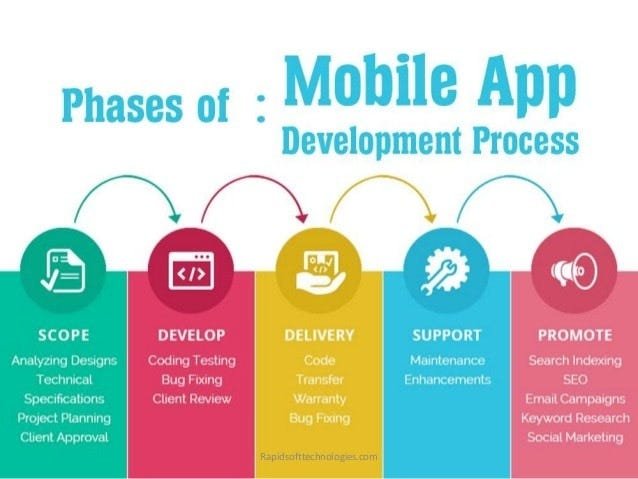Mobile app development is a multifaceted process that involves several phases, from the initial idea to the final product launch. Whether you’re a mobile app development company in Toronto, Dallas, or Austin, the steps followed to create a functional and scalable app remain largely consistent. Understanding these key phases is essential for businesses and entrepreneurs looking to build a robust mobile application that meets user needs and delivers a seamless experience.
In this comprehensive guide, we will explore the key phases of mobile app development, breaking down each stage to provide a clear roadmap of the development process.
1. Idea Generation and Conceptualization
The first step in any mobile app development process is generating the idea. During this phase, businesses or individuals need to identify the problem they aim to solve through the app. This is where brainstorming and research take center stage.
- Research: Competitor analysis, understanding market trends, and identifying target audience needs are critical in ensuring the app idea has a market fit.
- Business Goals: Define the core objectives of the app. What value will it provide to users? How will it align with the overall business strategy?
- Feature List: Create a rough feature list that outlines the app’s functionalities, making sure to prioritize the most critical features for version 1.0.
Many companies, such as mobile app development companies in Toronto, leverage their local market knowledge during this phase to cater to region-specific needs.
2. Planning and Strategy
After the initial idea is fleshed out, the next step is to develop a clear strategy for the mobile app. This involves setting the project’s scope, determining the budget, and creating a timeline.
- Platform Selection: Decide whether the app will be developed for Android, iOS, or both. Native apps (built for a specific platform) and cross-platform apps (designed to work across multiple platforms) are key considerations here.
- Technology Stack: Choose the right tools and technologies that will power your app. This could include programming languages (Swift for iOS, Kotlin for Android), frameworks (React Native, Flutter), and databases (Firebase, MySQL).
- Defining the MVP: Start with a Minimum Viable Product (MVP), a version of the app that contains only the most essential features. This allows for quicker launch times and feedback gathering.
Whether working with a mobile app development company in Dallas or another city, defining the MVP is crucial to meet the desired launch timeline and budget.
3. UI/UX Design
User experience (UX) and user interface (UI) design are two of the most critical phases in mobile app development. This phase determines how the app looks and feels to the end-user.
- Wireframes: Designers create wireframes that serve as the visual structure of the app. Wireframes offer a blueprint of how different screens and features will be laid out, focusing on functionality rather than aesthetics.
- Prototypes: Prototypes are clickable versions of the wireframes. They help in validating the flow of the app and allow stakeholders to interact with the app’s design before development starts.
- UI Design: This phase focuses on creating a visually appealing design, including the app’s color scheme, fonts, icons, and buttons. The goal is to craft a design that is both beautiful and intuitive to use.
For companies like mobile app development companies in Austin, providing an engaging and smooth design is essential to compete in tech-forward cities where users have high expectations.
4. App Development
The development phase is where coding takes place, and the design is transformed into a working mobile application. This phase typically involves two parts: front-end and back-end development.
- Front-End Development: This focuses on the parts of the app that users interact with. Front-end developers build the interfaces and implement the design using programming languages like Swift, Kotlin, or frameworks like React Native.
- Back-End Development: This includes the server, database, and APIs that enable the app to function behind the scenes. Back-end development ensures that the app can handle user data, communicate with servers, and function seamlessly.
- Integration of Features: Features such as push notifications, payment gateways, and user authentication are integrated during this stage.
For a mobile app development company in Toronto, collaboration between front-end and back-end developers is key to ensure seamless functionality across different devices and operating systems.
5. Testing and Quality Assurance (QA)
No mobile app is complete without thorough testing. This phase ensures that the app is bug-free, performs well under different conditions, and offers a smooth user experience.
- Functional Testing: Ensures that all features work as intended and meet the functional requirements outlined in the initial stages.
- Performance Testing: Evaluates how the app performs under different loads and conditions. This is critical to ensure the app doesn’t crash or slow down when usage spikes.
- Usability Testing: This phase checks how easy and intuitive the app is for users to navigate.
- Security Testing: Ensures the app is secure, particularly if it handles sensitive information such as personal details or payment data.
Companies like mobile app development company Dallas focus heavily on security testing to prevent data breaches and ensure compliance with local regulations.
6. Deployment and Launch
After the app has been thoroughly tested and any bugs have been fixed, it is ready for deployment. This phase involves launching the app in app stores like Google Play and Apple’s App Store.
- App Store Guidelines: Each platform has specific guidelines that developers must follow to ensure their app gets approved. This includes adhering to content guidelines, performance standards, and design specifications.
- Marketing Strategy: A solid marketing strategy is essential for a successful launch. This might include app store optimization (ASO), social media marketing, influencer outreach, and more.
- Initial User Feedback: Once the app is live, gathering feedback from early adopters is crucial. This feedback helps identify any remaining issues and areas for improvement.
For a mobile app development company in Austin, creating a buzz around the app’s launch, whether through local partnerships or digital marketing, can help drive initial downloads and engagement.
7. Post-Launch Support and Maintenance
The mobile app development process doesn’t end after launch. Continuous updates, maintenance, and support are required to ensure the app remains functional and competitive.
- Bug Fixes and Updates: Regular updates are necessary to fix bugs, improve performance, and introduce new features based on user feedback.
- Monitoring Performance: Developers will monitor the app’s performance in real-time to ensure it runs smoothly.
- New Feature Development: As user demands and market trends evolve, new features may need to be added to the app to keep it relevant and engaging.
Mobile app development companies in Dallas and Toronto emphasize the importance of long-term maintenance contracts to ensure their apps remain competitive in the rapidly evolving tech space.
Conclusion
The mobile app development process is a comprehensive and multi-phase journey that requires careful planning, execution, and ongoing support. Each phase plays a critical role in ensuring the app’s success in the marketplace, from idea generation to post-launch support.
Whether you’re collaborating with a mobile app development company Toronto, Dallas, or Austin, understanding these key phases will help you navigate the process smoothly and create a mobile application that not only meets user expectations but exceeds them.
At the end of the day, the right combination of innovation, user-focused design, and thorough testing can transform your idea into a successful mobile app.
Call to Action
Ready to take your mobile app idea to the next level? Contact our team of expert developers at NAO for customized solutions that cater to your business needs. Whether you’re in Toronto, Dallas, or Austin, we’ve got you covered. Let’s build something great together!




